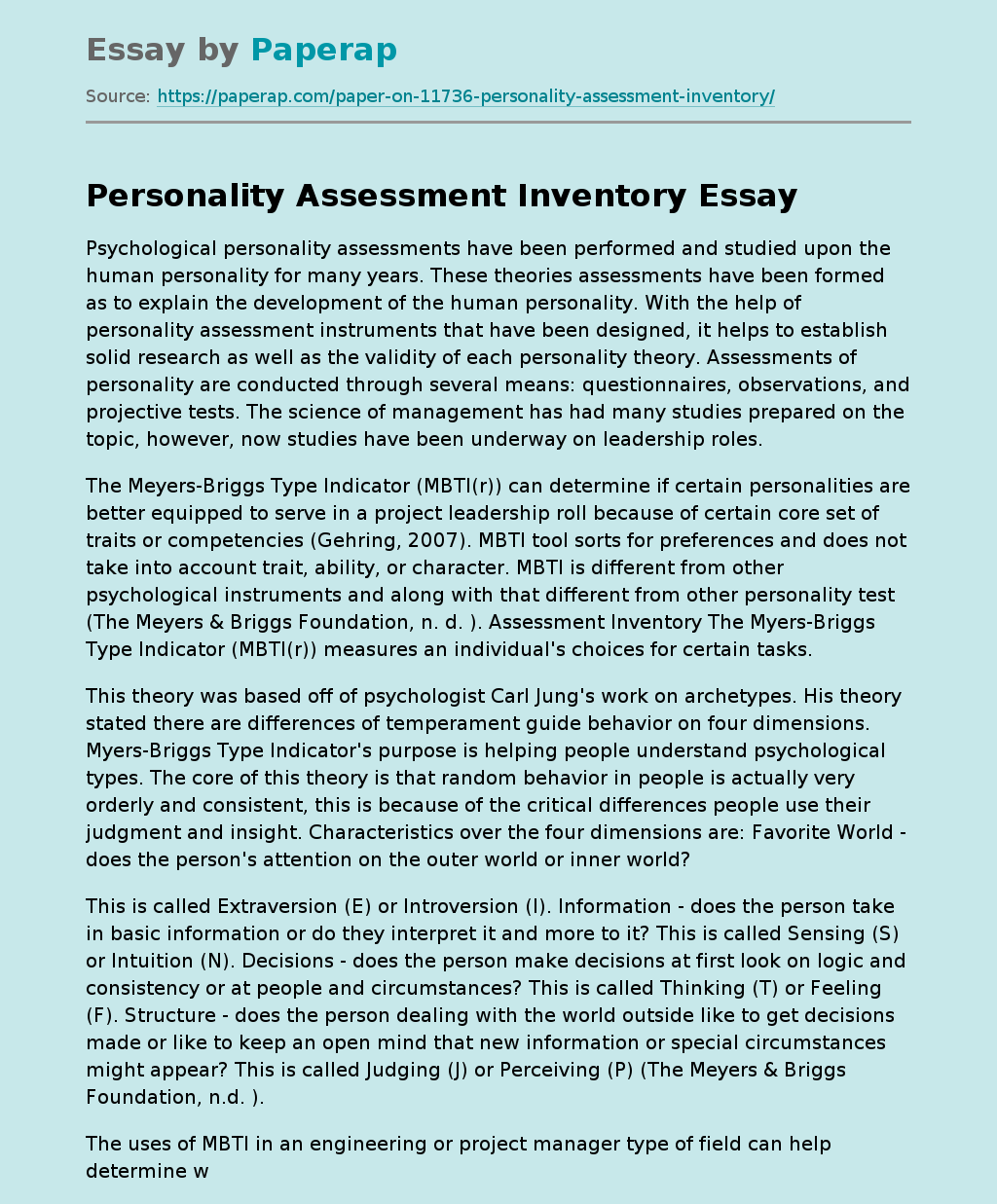Personality Assessment Inventory
Psychological personality assessments have been performed and studied upon the human personality for many years. These theories assessments have been formed as to explain the development of the human personality. With the help of personality assessment instruments that have been designed, it helps to establish solid research as well as the validity of each personality theory. Assessments of personality are conducted through several means: questionnaires, observations, and projective tests. The science of management has had many studies prepared on the topic, however, now studies have been underway on leadership roles.
The Meyers-Briggs Type Indicator (MBTI(r)) can determine if certain personalities are better equipped to serve in a project leadership roll because of certain core set of traits or competencies (Gehring, 2007). MBTI tool sorts for preferences and does not take into account trait, ability, or character. MBTI is different from other psychological instruments and along with that different from other personality test (The Meyers & Briggs Foundation, n. d. ). Assessment Inventory The Myers-Briggs Type Indicator (MBTI(r)) measures an individual’s choices for certain tasks.
This theory was based off of psychologist Carl Jung’s work on archetypes. His theory stated there are differences of temperament guide behavior on four dimensions. Myers-Briggs Type Indicator’s purpose is helping people understand psychological types. The core of this theory is that random behavior in people is actually very orderly and consistent, this is because of the critical differences people use their judgment and insight. Characteristics over the four dimensions are: Favorite World – does the person’s attention on the outer world or inner world?
This is called Extraversion (E) or Introversion (I).
Information – does the person take in basic information or do they interpret it and more to it? This is called Sensing (S) or Intuition (N). Decisions – does the person make decisions at first look on logic and consistency or at people and circumstances? This is called Thinking (T) or Feeling (F). Structure – does the person dealing with the world outside like to get decisions made or like to keep an open mind that new information or special circumstances might appear? This is called Judging (J) or Perceiving (P) (The Meyers & Briggs Foundation, n.d. ).
The uses of MBTI in an engineering or project manager type of field can help determine what fields of engineering is most suitable for a person. MBTI has shown different work environments attract a certain type of engineer. MBTI has also shown when given to those specific people that those engineers that score high on Feeling and Perceiving are predisposed to leave consulting engineering earlier then those that scored high as a Thinker and Judger. Feeling and Perceiving personalities will join academia, public agencies, regulatory agencies, or research organizations.
MBTI has shown individuals Feelings and Extraversion preferences in the engineering field within two years transfer to other fields outside engineering curricula (Culp & Smith, 2009). By being able to administer MBTI can cut down on high turn over rates in a work place. It cost time and money to run ads for employment, job training, and paperwork. The purpose of choosing MBTI is individual’s are geared differently at perceiving information and how they use the information they receive (Chae et. , al. ,2003).
With keeping this in mind it takes certain type of personalities to work in the field of engineering and/or being a project manager. Assessing this information gives a better understanding of the person from whom you will be or might be hiring. Analyze Selected Assessment with Personality Theories Carl Rogers was a significant America psychologist and one of the originators of the concern for people method to psychology. Rogers used a nondirective method of helping the individual. He did not ask questions, he just listened to what the individual had to say.
He accepted the individual for who he or she was (Kirschenbaum, 2004). Even though MBTI is a questionnaire there is no administrator asking the questions. Only an administrator who scores the questionnaire; the individual is accepted no matter the final scoring of the questionnaire. Carl Rogers approach and the MBTI both help individual’s see who they are and possible areas of improvement. Research Findings The Myers-Briggs Type Indicator (MBTI(r)) assessment is a science of psychological measurement questionnaire designed to measure preferences in how individuals perceive and make decisions.
Myers and Briggs preferences were infer from Carl Gustav Jung’s typological theories published in his 1921 book called Psychological Types (The Meyers & Briggs Foundation, n. d. ). Myers and Briggs started constructing the indicator during World War II. It was Myers and Briggs belief, knowledge of personality preferences would help woman entering the industrial workforce for the first time. This assessment would indicate what type of job(s) women would feel most comfortable and successful in.
This questionnaire grew into what is now known as the Myers-Briggs Type Indicator. The MBTI concentrates on standard populations and accentuates the significance of naturally taking place distinctions (The Meyers & Briggs Foundation, n. d. ). This assessment performs greatly since it can be taken by any individual from any background and come up with a career field more in tune with the individual’s personality style. It executes completely in terms of the personality assessment of target population.
In regards to target population the MBTI it used frequently in areas of career counseling, team building, group dynamics, professional development, leadership training, engineering, and project management. As in project management, results clearly indicate that there is a set of leadership traits that, if the individual possesses there is greater probability for the project to be a success. Furthermore, MBTI has an instrument that can be used in selecting project leaders who naturally possess project leader traits (Gehring, 2007).
Personality Assessment Inventory. (2017, Dec 30). Retrieved from https://paperap.com/paper-on-11736-personality-assessment-inventory/

